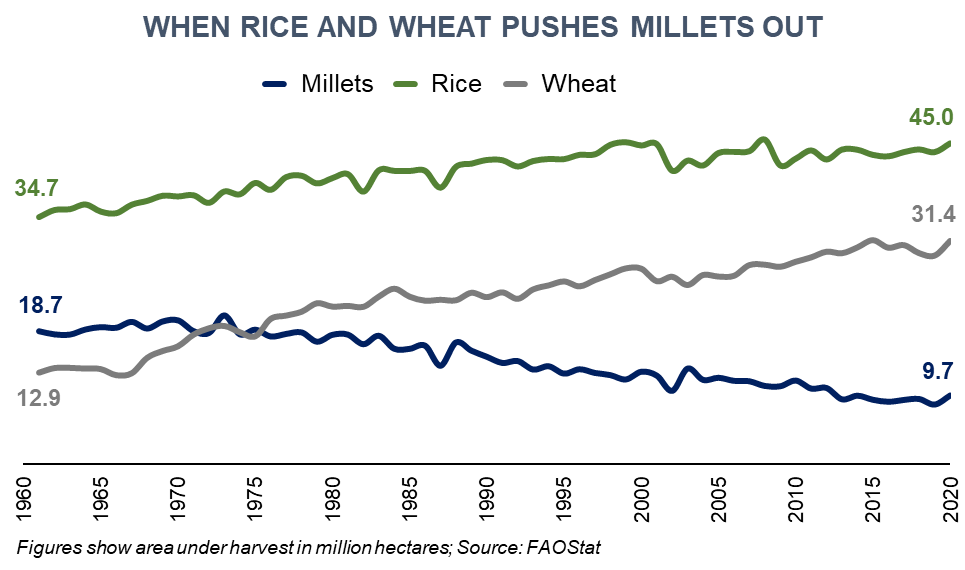India’s Prime Minister has repeatedly mentioned during his speeches the importance of growing demand for millets which could enhance the income for the growers and better nutrition available for the consumers. The Government of India had marked 2018 as the national year of millets to promote the production and consumption of millets. Recently, the United Nations General Assembly unanimously adopted a resolution initiated by India with Bangladesh, Kenya, Nepal, Nigeria, Russia, and Senegal to mark 2023 as the 'International Year of Millets'. India has recognized three main objectives for 2023 observance: i. increasing awareness of the contribution of millets for food security and nutrition; ii. inspiring stakeholders, including national governments to work towards improving production, productivity, and quality of millets; and iii. improving focus for enhanced investment in research & development and extension services for millets. Over the years, millets have entered India’s food security benefits schemes for improving national nutritional requirements.
The COVID-19 pandemic has posed challenges at overcoming the nutrition crisis, not only for India but globally. It has emphasized the importance of sustainable eating to reduce malnutrition, hidden hunger, and diet-related non-communicable diseases. Further, with climate change as a serious threat across the world, practices such as climate-smart agriculture and sustainable food production have become pertinent. These challenges can also be dealt with a concentration on the production and consumption of millets. Millets are traditional grasses/crops that can be grown in arid environments and are considered to do perform in drought-like conditions, according to Food and Agriculture Organization. Therefore, millet farming also results in the preservation and conservation of biodiversity.
There are some key dynamics of making millets revolution sustainable in India, which require women farmers’ engagement and can empower them:
Producer Friendly Ecosystem: In the late 60s, the green revolution in India promoted rice and wheat production which posed a negative impact concentrating on the single crop in one land idea. Moreover, led to environmental degradation, water table depletion and infertile land focusing shifts on the farming pattern over the years. Price Support benefits favouring these crops, with private players involved in the promotion of its hybrid seeds and agrochemicals hindered the promotion of millets.

Since most of the millet growers are smallholder farmers, mostly tribals, have less access to resources. Some of the measures to resolve their challenges are:
- Availability of high yielding varieties of millets suitable to the local climate. Government research institutions in India can play a leading role in releasing high yielding varieties with resistance to biotic and abiotic stress. Private players in the seed industry should also contribute to this research to augment the productivity of millets.
- Provision of input subsidies like drip or sprinkler irrigation, biofertilizers to promote the production of millets and assured buy-back mechanism via Government agencies incorporating it in food security systems.
- Concentration on the promotion of India’s commitment to biofortified crops. Indian prime minister dedicated 17 biofortified varieties of eight crops, which included two varieties of finger millets and one variety of little millet which addresses the concerns of production alongside better nutrition outcomes.
Improved Women Farmers’ Engagement: According to Periodic Labour Force Survey 2019-20, 59.9 per cent of women in India are agriculture workers. For rural India, the percentage is 75.7. Furthermore, Economic Survey 2017-18, stated that with growing rural to urban migration by men, there is ‘feminisation’ of the agriculture sector, with an increasing number of women in multiple roles as cultivators, entrepreneurs, and labourers. This workforce needs to be extensively leveraged in the millet revolution. Women farmers, with their ecological acumen and their close association with climate protection, are best suited to be ambassadors of millet cultivation. Efforts towards providing agriculture inputs to and building the capacity of women farmers in sustainable millet production can be a game-changer in the millet revolution. This will also ensure women farmers’ economic empowerment.
Women are also the primary provider of food within the household, therefore, women farmers and/or self-help group members can be trained and equipped in agro-processing and marketing of millets which will increase consumption patterns. Women entrepreneurs can be developed who focus on the sale of millet produce such as ragi cookies, bajra biscuits, jowar namkeen, to name a few for increasing availability of millet products. Furthermore, angandwadi and ASHA workers can be leveraged to disseminate knowledge on the benefits of the consumption of millets.
Market Friendly Ecosystem: Presently, due to dispersion in millet grown areas, the value chain is highly fragmented with limited to no access to private sector market actors. Given this, there are many intermediaries in the chain reaping benefits by stockpiling the goods. Over the last couple of years, private sector actors have launched millets-based products to meet the high rising urban consumer’s demand expanding its market. Many multinationals like Kellogg’s, ITC, and PepsiCo alongside many start-ups have entered the millet value chain launching a range of products such as bakery products, snacks, and cereals.
To strengthen the millet market ecosystem, the following measures could be undertaken:
- Establish primary and secondary processing centres in the vicinity of production are to help producers’ couture higher value. Community-owned processing units facilitated by farmer collectives can an instrumental role in leveraging economies of scale.
- Corporates and start-ups in the food processing industry can assist through better branding prospects with food quality/safety standards to increase consumer awareness of its nutritional benefits.
Policy friendly ecosystem: Design policy framework with an actionable plan for implantation to help in achieving the goal of nutritional security through promotion of millets.
- A dedicated panel constituting professionals such as policymakers, research institutions, state representatives, the private sector, and civil societies should be part of the millet promotion mission for effective coordination.
- The convergence of ministries such as Agriculture, Health, and Women & Child Development to ensure better coordination for program implementation in a specified time.
These efforts combined will help India in the millet revolution that can improve nutrition, climate and women empowerment outcomes.
This blog has been authored by Guriya.


